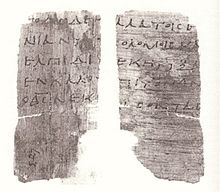Halöŵö Zinenge

Halöŵö Zinenge (Yunani föna: Πράξεις Ἀποστόλων, Práxeis Apostólōn;[1] Latin: Actūs Apostolōrum) ya'ia da'ö no sura silima bakha ba mbuku Gamabu'ulali Sibohou; khönia bakha tetutunö waö-waö wamasindro Gereja ba famazaewe turiania ba zi sagörö tanö si so barö wamatörö Roma.[2]
Halöŵö Zinenge (HalZin) faoma Injil Luka ya'ia da'ö no dombua faosatö moroi ba zi sambua zinura Luka-HalZin, nisura samösa niha si lö ta'ila töi.[3] Laŵaö bakha ba tradisi wa sanura ya'ia no Luka, samösa dokter sango'awögö Faulo ba wekolinia. To'ölö laŵaö wa tesura ia 80–90 furi Keriso, heŵa'ae so gere Zura Ni'amoni'ö sanguma'ö 110–120 furi Keriso.[4] Bakha ba waosatö si sara, Injil Luka, tetutunö hewisa ifönui gamabu'ulalinia Lowalangi ba wangorifi ulidanö bakha ba wa'auri, fa'amate ba femaoso Yesu moroi ba Nazareta. Itohugö HalZin faoma waö-waö ndra Niha Keriso ba ngaotu ndröfia si sara, tebörögö ba wanahae Yesu ba zorugo. Salua nitutunö bakha ba faza ba mböröta zura alua ba Yerusalema, tetutunö ngaluo we'amöi tou Geheha Ni'amoni'ö (luo Pentakosta), famofanö ndra Niha Keriso moroi ba Yerusalema ba famasindro Gereja ba Antiokia. Bakha ba faza aefa da'ö tetutunö gamatohula duria Niha Keriso andrö nifalua Waulo ba te'o'ozui faoma fe'asonia ba gurunga ba Roma, ba wombaloi fanguhukunia.
Bakha ba Luka–HalZin itandraigö ibe'e wanemali ba wanofu bakha teologi, ya'ia da'ö hewisa wa tola la'o'ö khö Mesia Yahudi sambua Gereja, si fao awö khönia abölö oya niha si tenga Yahudi; fanemali ba da'ö ya'ia wa oroisa Keriso tebe'e khö niha bö'ö börö me lö latema ia ira niha Yahudi.[2] Tola göi tobali Luka–HalZin fombelegö ndra solohi khö Yesu föna ndra niha Yahudi: oya huhuo ba famotokhi taromali bakha ba HalZin tetandrösaigö khö ndra niha Yahudi, ba niha Roma tobali samabali ba wasöndratali sanandrösa ba hada ba huku Yahudi.[5] Baero da'ö molo'ö Luka, ira solohi khö Yesu no sambua wa'awösa bakha ba niha Yahudi, ba börö da'ö lasöndra wa'edöna huku tobali sambua agama nitema'ö; aefa da'ö, hulö lö i'ila sibai Luka hewisa gohitö dödö Lowalangi ba zi so föna khö ndra niha Yahudi ba niha Keriso, heŵa'ae latema'ö wa'aniha Yahudi Yesu ba solohi khönia si föföna, lö aetu göi ifatörö dödö zombaso wa no latimbagö Mesia ira niha Yahudi.[6]
Famaosatö ba nahia
[bulö'ö | bulö’ö kode]Awena irugi da'a te'ali ba li Niha moroi ba li Inggris
Umbu
[bulö'ö | bulö’ö kode]- ↑ Matthews 2011, hlm. 12.
- ↑ 2,0 2,1 Burkett 2002, hlm. 263.
- ↑ Burkett 2002, hlm. 195.
- ↑ Tyson, Joseph B., (April 2011). "When and Why Was the Acts of the Apostles Written?", in: The Bible and Interpretation: "...A growing number of scholars prefer a late date for the composition of Acts, i.e., c. 110-120 CE. Three factors support such a date. First, Acts seems to be unknown before the last half of the second century. Second, compelling arguments can be made that the author of Acts was acquainted with some materials written by Josephus, who completed his Antiquities of the Jews in 93-94 CE...Third, recent studies have revised the judgment that the author of Acts was unaware of the Pauline letters."
- ↑ Pickett 2011, hlm. 6–7.
- ↑ Boring 2012, hlm. 563.
Wikipedia no halöŵö nifalului zato.
Tolo Wikipedia ba wanohugö wanura ya'ia, na so khöu onönöta nösi. Saohagölö.
- Nga'örö si so fanura ba li non-Indonesia
- Nga'örö si so fanura ba li Latin
- Sura ba Wikipedia faoma fanandra BNF
- Nga'örö faoma kategori pengawasan otoritas si lö ösi
- Sura ba Wikipedia faoma fanandra GND
- Sura ba Wikipedia faoma fanandra NKC
- Sura ba Wikipedia faoma fanandra NSK
- Sura ba Wikipedia faoma fanandra SUDOC
- Halöŵö Zinenge
- Sura Ni'amoni'ö
- Amabu'ulali Sibohou
